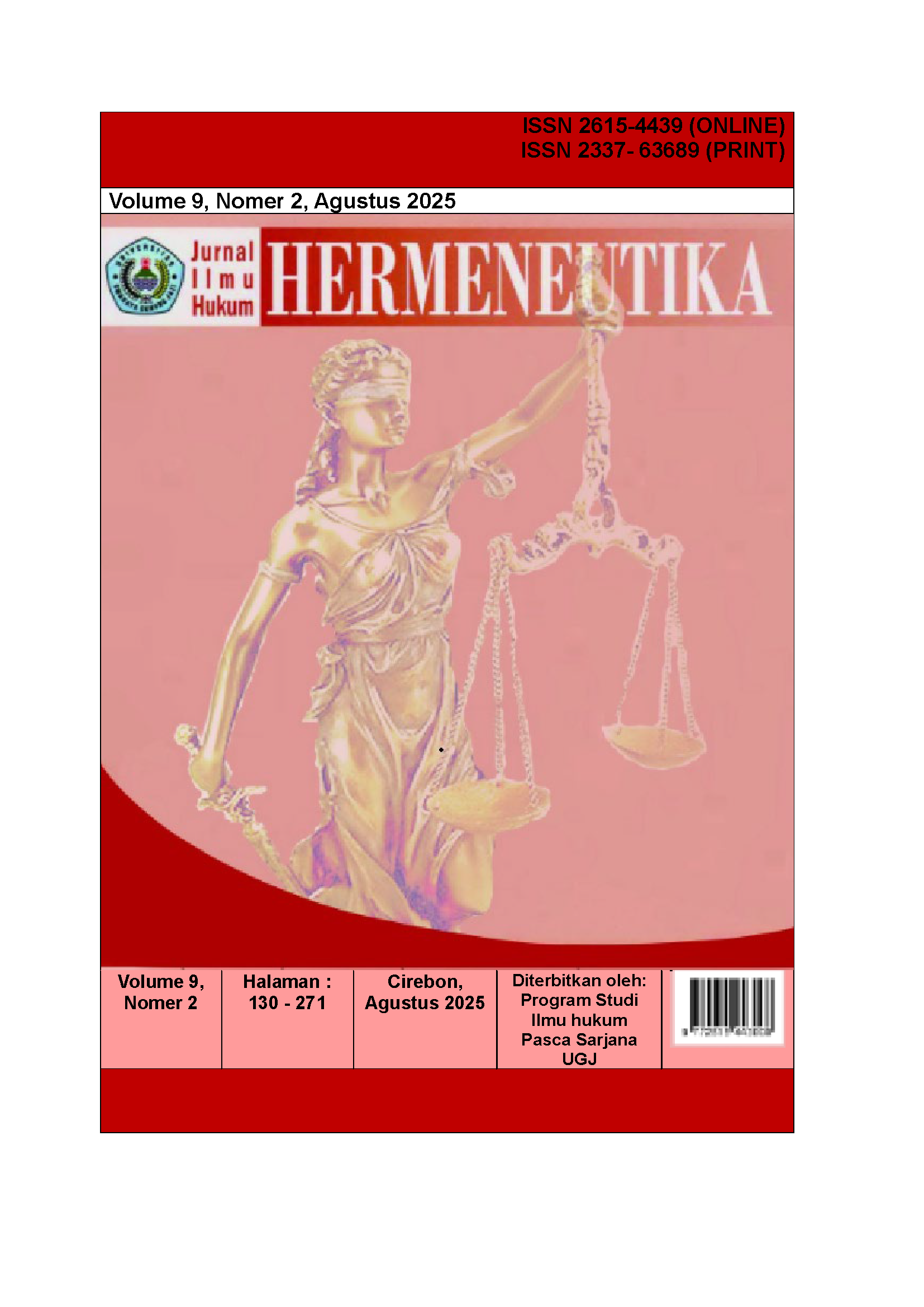IMPLEMENTATION OF HUMAN RIGHTS-BASED PUBLIC SERVICES AND BUSINESS WITH AN IMPACT ON JUSTICE
DOI:
https://doi.org/10.33603/hermeneutika.v9i2.10785Keywords:
: human right, public service, impact justiceAbstract
The advancement of trade during the Era of Globalization and Era 4.0, characterized by the integration of digital technology and automation, has heightened rivalry in both national and international markets. In the realm of Intellectual Property, dominant trademarks serve as symbols and identities for products, enhancing the image of businesses. As integral components of Intellectual Property (IP), these brands necessitate legal protection and certainty to foster healthy competition and prevent counterfeiting and trademark infringement. Trademark protection is governed by Law Number 20 of 2016 regarding Trademarks and Geographical Indications. This study utilizes a normative legal research methodology, relying on secondary sources as the principal material, specifically legal statutes and judicial rulings. This study aims to examine the legal protection of registered trademarks in Indonesia as established by positive law and the application of the Trademark Law in trademark disputes, including the case of PT—Gudang Baru, which features a similar brand. Consequently, a research is required to investigate the function of Indonesian law enforcement in adjudicating trademark disputes. Trademark disputes may be settled through mediation prior to being presented to the commercial court. Criminal sanctions may be enforced if a civil settlement fails to resolve the problem, grounded in the principle of Ultimum Remedium, which posits that criminal penalties are employed solely as a last resort in legal matters, particularly in dispute resolution law.
References
Abrianti, R. P. (2016). Juridical Analysis of the Supreme Court Decision Number 162 K/Pdt. Sus-HKI/2014 concerning Trademark Similarities between Salt Warehouse and New Warehouse
Arifin, Z. & Iqbal, M. (2020). Legal protection of registered trademarks. Ius Constituendum, 5(1), 47-54.
Balqiz, G. W. (2021). Trademark Protection as an intellectual property right study in the city of Semarang, Indonesia. Journal of Judicial Review, 23(1), 41-45.
CNN Indonesia. (2021). Getting to Know Gudang Baru, the Company Sued by Gudang Garam
Government Regulation No. 51 of 2007 concerning Geographical Indications
Gultom, M. H. (2018). Legal protection for registered trademark rights holders against trademark infringement. Jurnal Warta (56).
Hajizi, M. I., Wafa, M. A., & Yasir, M
Hastuti, I. (2019). Legal protection for well-known owners based on law number 20 of 2016 concerning trademark rights and geographical indications. Scientific Journal of Law and Social Dynamics, 16(2), 174-184.
Law Number 15 of 2001 concerning Trademarks
Law Number 20 of 2016 concerning Trademarks and Geographical Indications
Nopiana & Disemadi, H. S. (2021). Legal protection of trademark rights holders: A comparative study between Japan and Indonesia. Jurisprudence: Journal of Law, 4(2), 289-400.
PT. Salt Warehouse
Regulation of the Minister of Law and Human Rights Number 10 of 2022 concerning Geographical Indications (Use of the National IG Logo).
Regulation of the Minister of Law and Human Rights Number 12 of 2019 concerning Geographical Indications
Regulation of the Minister of Law and Human Rights Number 42 of 2016 concerning Electronic Intellectual Property Application Services.
Shaleh, A. I. & Trisnabilah, S. (2020). Legal protection of trademark similarities for similar goods or services: bossini brand study. Journal of Judicial Review, 22(2), 291-300.
Sheilindry, I., Mada, A. Z. & Syarifudin, A. (2021) Protection of intellectual property rights in electronic business contracts for trademark rights holders. Simbur Cahaya : Journal of Legal Sciences, 28(2), 282-294. 10.28946/sc.v28i2.1317.
Sidik, S. (2021). Brand Lawsuit! Gudang Garam vs Gudang Baru,
Surabaya Commercial Court, Decision Number 4/Pdt.Sus-HKI/Memerk/2021/PN Niaga Sby.,
Yessiningrum, W. R. (2015). Legal protection on geographical indication as a part of intellectual protection rights. Law and Justice Studies, 43–53.
Downloads
Published
Issue
Section
Citation Check
License
Copyright (c) 2025 Sri Kurniati Handayani Pane

This work is licensed under a Creative Commons Attribution-ShareAlike 4.0 International License.
The Authors submitting a manuscript do so on the understanding that if accepted for publication, copyright of the article shall be assigned to Jurnal HERMENUTIKA, Sekolah Pascasarjana Ilmu Hukum. Universitas Swadaya Gunung Jati as publisher of the journal. Copyright encompasses rights to reproduce and deliver the article in all form and media, including reprints, photographs, microfilms, and any other similar reproductions, as well as translations.
Jurnal HERMENEUTIKA, Universitas Swadaya Gunung Jati and the Editors make every effort to ensure that no wrong or misleading data, opinions or statements be published in the journal. In any way, the contents of the articles and advertisements published in Jurnal HERMENEUTIKA are the sole responsibility of their respective authors and advertisers.










